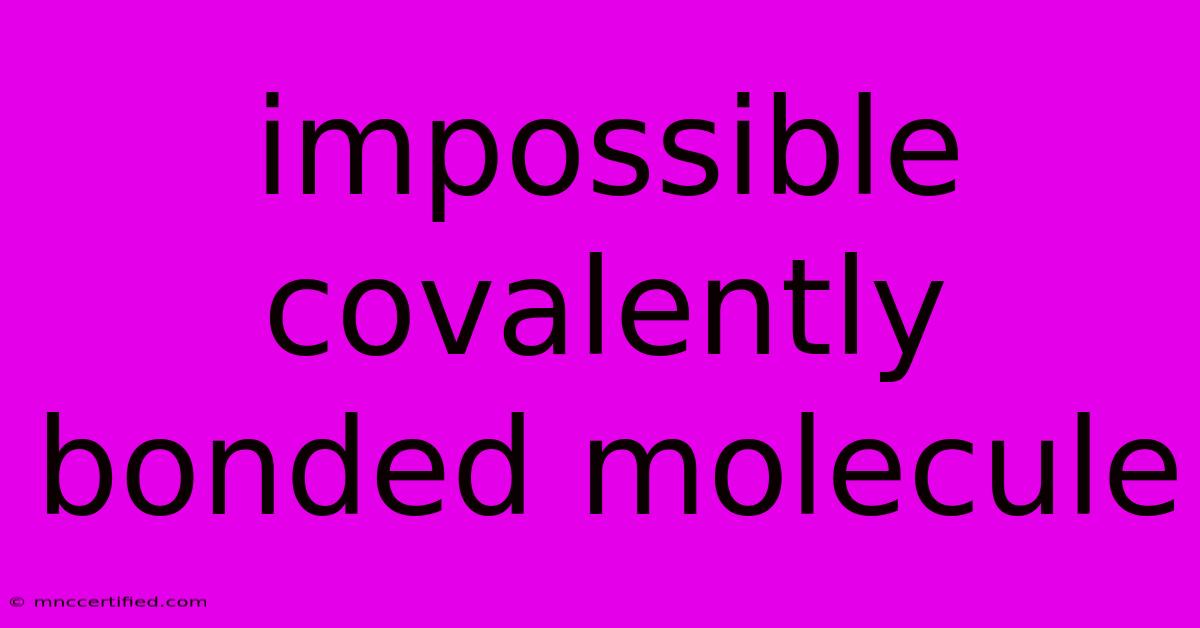Impossible Covalently Bonded Molecule

Table of Contents
The Forbidden Bonds: Exploring Impossible Covalently Bonded Molecules
The world of chemistry is built on the foundation of bonds, with covalent bonds being a cornerstone. These bonds, formed by the sharing of electrons between atoms, are responsible for the vast array of molecules that make up our universe. But what if we told you there are molecules that, according to the rules of chemistry, shouldn't exist?
These are the impossible covalent bonds – molecules that defy conventional wisdom and challenge our understanding of chemical bonding. Let's delve into the fascinating world of these "forbidden" molecules.
Breaking the Rules: Why These Bonds Should Not Exist
The stability of covalent bonds is dictated by several fundamental factors:
- Electronegativity: The ability of an atom to attract electrons. A significant difference in electronegativity between two atoms often leads to ionic bonding, not covalent bonding.
- Valence Electrons: The number of electrons an atom can share to form bonds. Atoms typically form bonds to achieve a stable octet (8 valence electrons).
- Atomic Radius: Larger atoms have weaker bonds due to greater distance between nuclei.
When these factors are in conflict, it creates a scenario where a covalent bond seems improbable.
The Quest for the Impossible: Examples of "Forbidden" Molecules
Despite the constraints, scientists have identified a few molecules that seem to defy these rules:
- Helium Hydride (HeH+): This molecule, comprised of helium and hydrogen, is a true anomaly. Helium, with its full outer shell of electrons, is notoriously unreactive, making the formation of a covalent bond with hydrogen highly unexpected. However, HeH+ exists and is even observed in interstellar space!
- Argon Fluorohydride (ArFH): Similar to helium, argon is a noble gas known for its lack of reactivity. Yet, ArFH has been experimentally verified, defying the conventional understanding of argon's bonding behavior.
- Tetrahedral Helium (He4): This molecule is a theoretical concept, with calculations suggesting that four helium atoms could theoretically bond to form a tetrahedral structure. While yet to be synthesized, the possibility of this "forbidden" molecule is intriguing.
Understanding the Exceptions: Exploring the Possibilities
Why do these molecules exist, despite the seemingly impossible conditions? The answer lies in the complex interplay of factors that determine chemical bonding.
- Environmental Factors: The presence of specific conditions like high pressure or extreme temperatures can influence bond formation.
- Quantum Effects: At the atomic level, quantum mechanics plays a significant role in determining the stability of bonds. These effects can override classical expectations and allow for the formation of unexpected bonds.
- Weak Interactions: Some "impossible" bonds might involve weak interactions like van der Waals forces or hydrogen bonding, which can stabilize the molecule despite the lack of a strong covalent bond.
The Future of "Forbidden" Chemistry
The study of impossible covalent bonds is an exciting frontier in chemistry. By exploring these exceptions, we can gain a deeper understanding of chemical bonding and the forces that govern the formation of molecules. This knowledge can lead to new insights into:
- Materials Science: Exploring new materials with unique properties based on these unconventional bonds.
- Astrochemistry: Understanding the formation of molecules in the vastness of space and their role in the evolution of the universe.
- Theoretical Chemistry: Pushing the boundaries of computational chemistry to accurately predict the behavior of these "forbidden" molecules.
The existence of these seemingly impossible covalent bonds highlights the dynamic and ever-evolving nature of chemistry. It reminds us that there are always new discoveries to be made and challenges to be overcome in this fascinating field. As we continue to explore the world of molecules, we may be surprised by the unexpected bonds that await us.

Thank you for visiting our website wich cover about Impossible Covalently Bonded Molecule. We hope the information provided has been useful to you. Feel free to contact us if you have any questions or need further assistance. See you next time and dont miss to bookmark.
Featured Posts
-
Emotional Moment Pete Wicks Cries On Strictly
Nov 10, 2024
-
Arcane Season 2 A Luxurious Animated Return
Nov 10, 2024
-
Premier League Brighton Vs Man City Live Score
Nov 10, 2024
-
Does Delta Dental Insurance Cover Tmj
Nov 10, 2024
-
2024 11 08 Suns Vs Mavericks Game Report
Nov 10, 2024